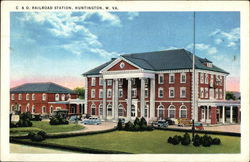Three Railroads
Railroads formed the foundation for the rise of King Coal.
When West Virginia became a state in 1863, 90 percent of its population lived on
farms. In 1870, only 85 coal mines were in operation. Most of the state, particularly
Southern West Virginia, was still rural and isolated from industy.
Just before the Civil War, the Baltimore & Ohio Railroad shifted the fortunes of what
would become northern West Virginia—even shaping the new state’s boundaries. In 1873,
the arrival of the Chesapeake & Ohio (C&O) Railway would have a similar impact on southern West Virginia.
Chesapeake & Ohio
Early attempts to connect the Atlantic Ocean and the Ohio River by rail failed. However,
after the Civil War, railroad magnate Collis P. Huntington took control of the Covington
& Ohio Railroad, renamed it the Chesapeake & Ohio (C&O), and extended the line from
Clifton Forge, Virginia, to the luxurious resort at White Sulphur Springs. Between 1869
and 1873, crews laid rails west from White Sulphur Springs and east from the Ohio River.
The strenuous work was extremely dangerous and paid very little. The crews consisted
principally of recent immigrants to the country and African Americans, many of whom
had been freed from slavery only a few years before.
The crew’s greatest engineering feat was the Great Bend (sometimes referred to as
Big Bend) Tunnel at Talcott in what soon would become Summers County, where the
C&O engaged the latest steam-powered machinery to assist with the construction.
The Great Bend possibly was the birthplace of the “John Henry” folk song, in which the
legendary steel driver defeated a steam shovel in a digging contest. The song foreshadowed
an age in which machines would take the places of workers.
C&O officials drove the final spike on a frigid day at Hawks Nest in Fayette County on
January 28, 1873. The new railroad finally connected the nation’s East Coast with southern
West Virginia, via the towns of White Sulphur Springs, Hinton, Charleston and the newly
created city of Huntington—named in honor of the railroad’s president.
The C&O—along with two competitors waiting in the wings—served two main purposes:
importing miners and exporting coal.
Norfolk & Western
Southern West Virginia’s second major railroad, the Norfolk & Western (N&W), traces its
roots to three Virginia railroads that played significant roles during the Civil War and were
merged in 1870. In 1881, the bankrupt railroad was sold to E. W. Clarke & Co. and
renamed the N&W.
With infusion of money from the Philadelphia area, the N&W was completed through
southern West Virginia to Pocahontas, Virginia. It quickly became the leading hauler of
Pocahontas coal. The Pocahontas Coalfield boasted the thickest bituminous coal seam in
the world—as high as 14 feet in some places. In addition, Pocahontas coal burned cleaner
than other bituminous coals, or, as an inspired marketing executive dubbed it, “smokeless
coal.” Overnight, the Pocahontas Coalfield—located primarily in McDowell and Mercer
counties—became the most valuable coal-producing region in the world.
By 1892, the N&W had been extended to the Ohio River at Kenova, sparking the rapid
growth of towns along the way, including Welch and Williamson. Bluefield’s population
grew from 600 to 11,188 people in just 20 years. One small Mercer County town became
a banking center for leading coal operators; Bramwell became known as the “home of
millionaires.”
Virginian
By 1900, the C&O and N&W had snaked branch lines into most valleys and hollows in
southern West Virginia. All that was left were the rugged mountains in between. By the
first decade of the 20th century, new machinery and engineering techniques allowed two
entrepreneurs to construct a railroad where few believed it could be built—along the crests
of narrow mountaintops and ridges.
The third major southern West Virginia railroad was the Virginian, the brainchild of coal
operator William Nelson Page of Ansted and Standard Oil executive Henry H. Rogers of
New York. In 1907 and 1908, crews were challenged to connect the former Tidewater
Railway in Virginia with West Virginia’s Deepwater Railway. The 443-mile-long railroad
was completed in 1909, linking southern West Virginia’s Winding Gulf Coalfield with the
Chesapeake Bay ports at Hampton Roads, Virginia.
The Virginian tapped previously unreachable coal reserves—namely in Raleigh, Fayette
and Wyoming counties—by employing the heaviest locomotives and longest lines of cars.
The ingenious railroad was an immediate boon to the towns of Princeton, Mullens, Glen
Rogers and Glen Jean.
By the early 20th century, branches of the C&O, N&W and Virginian extended into every
coal-producing hollow in southern West Virginia. Coal from the most remote valleys of
southern West Virginia could be shipped to the Atlantic Ocean, Great Lakes and every
major eastern market in a matter of days. These three railroads formed the foundation for
the rise of King Coal.
http://coalheritage.org/page.aspx?id=15
© 2015 Coal Heritage. All Rights Reserved.














